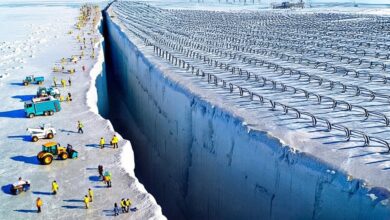A New Ocean Is Forming in Africa

### **A New Ocean Is Forming in Africa**
In 2005, in the Afar region of Ethiopia, a 35-mile (56 km) long rift suddenly appeared after the eruption of the Dabbahu volcano. This was not just a normal geological phenomenon, but also a sign that the African continent was gradually breaking apart, paving the way for the formation of a new ocean in the next few million years.
### **The Mystery of the Rift Zone**
The Afar region is where three major tectonic plates meet: the Nubian Plate (or African Plate), the Somali Plate, and the Arabian Plate. It is the center of the East African Rift System, a 6,000 km long rift system that stretches from the Red Sea through Ethiopia to Mozambique. This region is one of the most geologically active regions on Earth, where the crust is thinning and being stretched by the movement of the tectonic plates.
According to scientists, there is a “super plume” beneath this area – a giant mass of hot rock from deep in the mantle that pushes up to the surface, creating pressure that cracks the Earth’s crust. This leads to the formation of rifts, the separation of tectonic plates, and eventually the opening of new seas and oceans.
### **Journey to the Afar Region **
To verify the information and witness this special geological phenomenon with their own eyes, the team of authors made a journey to Ethiopia. From the capital Addis Ababa, they traveled by plane to Samara, then continued by off-road vehicle through the harsh desert to reach the Dabbahu fissure. This is a dangerous area, with temperatures reaching up to 50°C and constant volcanic activity.
They met local guides who described the area as a place where “the earth shakes and boils.” Just by walking on the ground, they feel the vibrations of the geological forces below. When standing on the edge of the crack, they hear a distinct rumbling sound and feel like they are standing on a hollow surface where the earth is constantly changing.

### **The Formation of a New Ocean**
The Dabbahu rift is just the tip of a larger process. According to geologists, this is where the Nubian and Somali plates begin to separate. The rift has widened by 8 meters since 2005. Over time, water from the Red Sea and the Gulf of Aden will flow in, creating a new inland sea. In about 5-10 million years, this area could develop into a full-fledged ocean, separating Somalia and other East African countries from the rest of Africa.
### **Life of the Afar**
In addition to its geological significance, the region is home to approximately 2 million Afar people, a nomadic people who make their living by raising livestock such as goats and camels, and trading salt. Despite their harsh living conditions, they have found a way to utilize the water from geothermal vents near the volcano to sustain their lives. These wells are formed from steam condensing underground, providing a precious source of pure water.
The Afar people face many challenges, including drought, disease, and conflict. The region has also seen political tension and violence, especially in recent years, making carrying weapons a necessity for self-defense.
### **The Greater Significance of the Afar Region**
The Afar region is not only a geological hotspot, but also a living testament to the transformation of the planet. It is the only place where humans can directly observe how an ocean is formed. This highlights the constant change of the Earth over millions of years.
A journey to the Afar region is not only educational but also inspiring about the adaptability of humans to harsh nature. This is the story of a land in constant change, a place that marks the intersection of Earth’s past, present and future.








